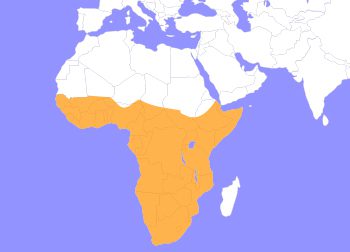Leopard Tortoise
Stigmochelys pardalis
Leopard Tortoises are only found in Africa, mostly in Eastern and Southern regions. They prefer dry areas with low vegetation, which is the main component of their diet. They are the fourth largest tortoise in the world (behind the African spurred, the Galapagos, and the Aldabra Giant) and will grow continuously throughout their entire life. Since they never stop growing, their size range is very large. The average is around 40 lbs, but these tortoises can weigh as much as 120 lbs. Adults will typically be about 1-2 ft long, depending on their age with females being larger than males.
They do not shed their shell as they grow, but rather just build up bigger scutes (bony plates on the shell) beneath the ones they have. This results in these scutes forming the pyramid-shaped bumps on their shells. Typically, they are yellow, tan, or light brown in color with black splotches or patterns on their carapace. Less so than the African Spurred Tortoise, they have large, sometimes pointed scales on their front legs. These tortoises do not exhibit parental care and hatchlings are immediately independent upon birth. If they make it past their first few days of life, they can live over 50 years, the high being 100 years.

Leopard Tortoises are distributed across regions of eastern and southern Africa, ranging from South Sudan to Namibia.
HABITAT -They prefer xeric or mesic (very dry) habitats that have low lying vegetation.
DIET -Mainly eating plant material, occasionally they will eat berries or other fruits if available.
FUN FACT -They are the most widespread tortoise in sub-Saharan Africa.
SOCIAL BEHAVIOR -They are docile with humans and solitary in the wild.
ACTIVITY -They are diurnal, unless it is too hot.
PREDATORS -Adults are preyed on by humans, but the eggs are preyed on by foxes, coyotes, and mongooses.
SIZE -They can grow up to 120 lbs and 1-2 ft long.
RELATIVES -They are related to other large tortoises like the African Spurred and Galapagos.
CONSERVATION -They are not evaluated by the IUCN.
Cub Creek Animal Care Information
Housing - All our tortoises have seasonal housing to accommodate their need for warm temperatures. In the summer, they lives in the Pentagon with our cavies and wallabies to enjoy the Missouri summer heat. They has a large area to explore, and are given a small pond to cool off in. When the temperatures start to drop, they are moved indoors to Lemur Landing and get to hang out with some of our lemurs, bettongs, and various birds. They loves this enclosure for its many crevices to burrow under, just like what they would do in the wild!
Diet - All of our tortoises are fed a mixture of fruits and vegetables, along with a calcium supplement to keep their shells strong and healthy. Their diet mainly consists of apples, sweet potato, and lettuce. Occasionally they’ll get treated with various other fruits and vegetables; a favorite of theirs is eggplant!
Enrichment - Our slow-moving tortoises definitely aren’t going to play chase, so instead for enrichment we give them various places to hide or climb over. During the summer, the campers will give them special treats to mix up their diet or put their food in novel locations, so the tortoises have to find it.

